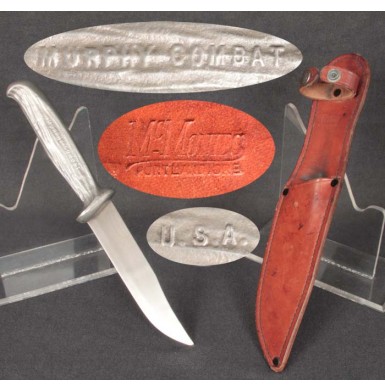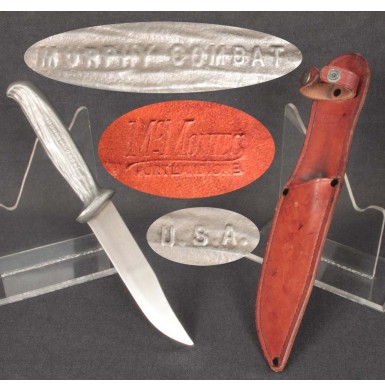Murphy Combat WWII Fighting Knife - About Mint
- Product Code: EWSK-1209-SOLD
- Availability: Out Of Stock
-
$1.00
The Murphy Combat Fighting Knife was produced during World War II by David Z. Murphy and his son David M. Murphy. Murphy was a custom knife maker who fist came to fame as the maker of the knives sold by the Gerber Legendary Blade Knife Company. The “Murphy” fighting knives are often categorized loosely as “Theater Knives”, even though they were not manufactured in a wartime theater of operations. They were, however, fighting knives manufactured for the explicit use of US military forces in combat during the Second World War. Murphy manufactured the knives in Gresham, OR and according to knife maker, researcher and author M.H. Cole (who interviewed David M Murphy), approximately 90,000 knives were produced during the war. This seems to be a very high number, considering the rarity of these knives on the market today. Several knife researchers and authors have postulated that either Murphy was simply incorrect in his estimate of total knives manufactured, or that somewhere along the line the production figures inadvertently received an extra “0” at the end, turning a much more believable total production of 9,000 into 90,000! The knives were produced in two sizes, a standard sized fighting knife with a 6 1/8” blade and a smaller 5” bladed “Jr” combat knife. The smaller knives are much less often encountered than the larger ones, although both are hardly common and in fact tend to be quite scarce. The knives were produced with cast aluminum hilts and bright polished blades, which were manufactured from power hacksaw blades. The larger knife has the words MURPHY COMBAT cast into the obverse grip and U.S.A. cast into the reverse grip. The smaller knife is marked MURPHY COMBAT JR on the reverse grip and U.S.A. on the obverse. The knives were supplied complete with a leather scabbard that was contoured to the guard of the knife and had a grip-retaining strap, which was secured with a snap. Several companies apparently manufactured the scabbards for Murphy, with Hamley’s Saddle Works of Pendleton, OR providing the bulk of the scabbards. M.H. Cole identifies at least four known WWII era scabbards for Murphy combat knives in his books, and assigns the variants numbers 1 through 4.
This Murphy Combat Fighting Knife is in about EXCELLENT to NEAR MINT condition. This is one of the larger knives, with the 6 1/8” long clip-point Bowie style blade and an overall length of 11 7/8”. The blade is truly about mint, and shows about 90%+ of its original polish, and retains its untouched factory edge with no indications of having been sharpened after leaving the Murphy manufactory. The cast aluminum hilt is crisply marked MURPHY COMBAT on the obverse and U.S.A. on the reverse. Since the aluminum hilts were cast, with the markings on them, they are sometimes blurred or weak. These markings are very crisp and clear, better than on the other Murphy I have owned. The knife is accompanied by its original “Number 3” (according to Cole) scabbard. The scabbard is clearly marked on front of the belt loop section, McMONIES / PORTLAND, ORE. The W.A. McMoneis company was a leather goods, harness and saddle maker based in Portland. McMonies produced US M-1916 holsters during WWI and presumably also produced M-1907 slings and rifle scabbards. Today their leather fishing creels are highly collectible and bring very high prices. The leather scabbard is nearly new as well and has clearly never been on a belt. The scabbard shows only some light scattered handling scuffs and some minor age discoloration, and some minor staining from storage. There is one large discolored patch where the aluminum guard of the knife has rubbed the scabbard for the last 66+ years. There is one tiny tear in the leather, around the lower of the upper two rivets. This is the result the knife being inserted and removed from the sheath, and appears to have actually been an accidental cut from the knife blade. The original retention strap and snap are in place and function perfectly. The scabbard retains all of its original stitching, which remains tight throughout. The original reinforcing rivets are present on the upper corners of the scabbard, as well as attaching the belt loop and the retention strap. The rivets retain about 90%+ of their original blackened finish on the front and 50%+ on the rear, with the finish loss apparently from storage.
Overall this is really an outstanding example of a very scarce and desirable Murphy Combat World War II fighting knife. The knife is really about mint and the scabbard is in outstanding condition as well. I sincerely doubt that you could improve on the condition of the knife, no matter how hard you tried. This knife would be a wonderful centerpiece to any collection of World War II era fighting knives and really deserves a place in a very advanced WWII edged weapons collection.
SOLD




